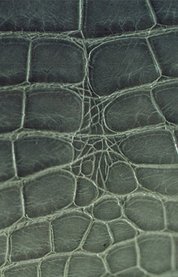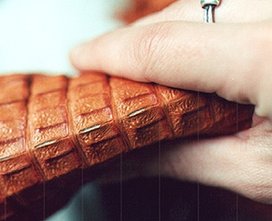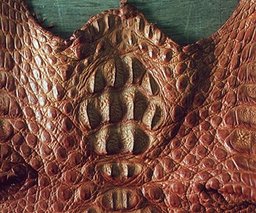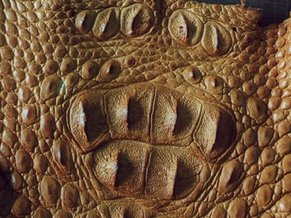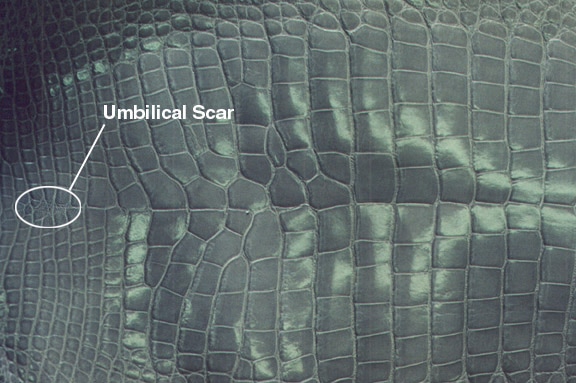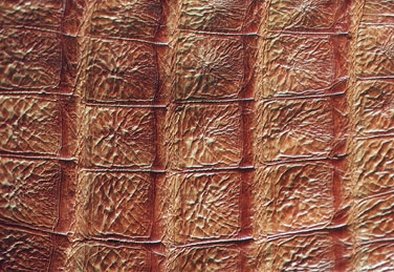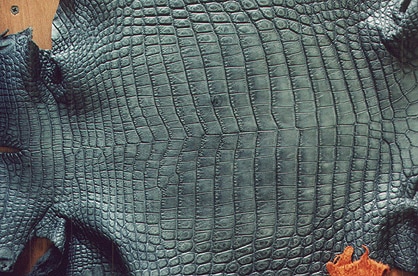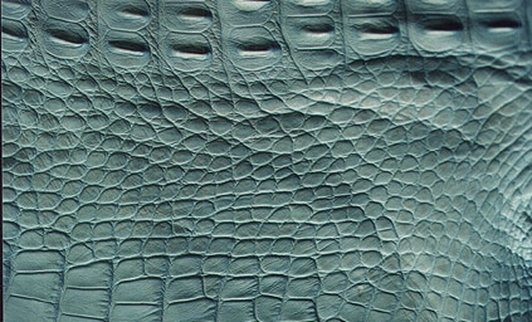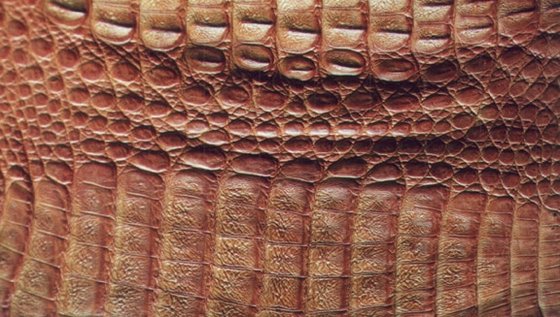Distinguishing Features of Crocodilian Leathers
Careful examination of the leather in a crocodilian product can give clear clues as to the species of origin. Products with large amounts of leather are generally easy to identify. Small products such as watch bands are much more difficult to distinguish.
This is especially important since the quality of crocodilian leathers varies greatly by species. Alligators and crocodiles are considered classic leathers and are high quality and high price. Caiman is an inferior product, is much cheaper on a wholesale level, and is more abundant in the market.
Although caiman has its place in the market, mislabeling has become such a problem that the buyer need beware. Many caiman products are marked crocodile or alligator and sold at the high prices of these classic leathers. Alligator is sometimes marked crocodile and crocodile marked alligator. Some of this is a cultural difference; Americans tend to call all "crocodile" alligator, and Europeans tend to call "alligator" crocodile. Upon close inspection, one will find that some large pieces have mixed leather in them. In the past it was fashionable to make a purse with alligator on one side and crocodile on the other. Today, due to product cost, it is not uncommon to see a purse with alligator or crocodile on the front and back and caiman on the sides with a caiman strap.
Faux designs are getting better and better and are increasingly becoming more difficult to identify. Some faux patterns are made by rolling something over a genuine hide to make the press. The finer details of faux are beyond the scope of this page, but here are tell-tale signs: the creases between the tiles are not deep and the pattern is often very repetitive.
This is especially important since the quality of crocodilian leathers varies greatly by species. Alligators and crocodiles are considered classic leathers and are high quality and high price. Caiman is an inferior product, is much cheaper on a wholesale level, and is more abundant in the market.
Although caiman has its place in the market, mislabeling has become such a problem that the buyer need beware. Many caiman products are marked crocodile or alligator and sold at the high prices of these classic leathers. Alligator is sometimes marked crocodile and crocodile marked alligator. Some of this is a cultural difference; Americans tend to call all "crocodile" alligator, and Europeans tend to call "alligator" crocodile. Upon close inspection, one will find that some large pieces have mixed leather in them. In the past it was fashionable to make a purse with alligator on one side and crocodile on the other. Today, due to product cost, it is not uncommon to see a purse with alligator or crocodile on the front and back and caiman on the sides with a caiman strap.
Faux designs are getting better and better and are increasingly becoming more difficult to identify. Some faux patterns are made by rolling something over a genuine hide to make the press. The finer details of faux are beyond the scope of this page, but here are tell-tale signs: the creases between the tiles are not deep and the pattern is often very repetitive.
Alligator Umbilical Scars
|
The single most distinguishing feature of alligator leather is the umbilical scar. The alligator is the only crocodilian that has this feature. Designers will often put this section of the leather prominently on their products to make the authenticity of the leather evident. As many as three may be used in making a purse. The umbilical scar is an elongated star shape with a webbing pattern in it. Finding this mark on leather identifies it as genuine alligator.
|
Pliability
Head Bumps
Another way the unpracticed eye can easily distinguish alligator leather is by counting the bumps on the back of the head. At the base of the head crocodilians have a pattern of bumps that is unique to each species.
Belly Scales and Patterns
The belly scales of the alligator and crocodile are smooth and pliable. This smoothness and the homogenous nature of alligator and crocodile skins allows dyes to distibute evenly in the leather. The bony deposits in the caiman skin will not allow dyes to distribute evenly and causes crinkling in the belly scales. If you see splotchy patterns in the dye, then you are looking at caiman.
The alligator has a slightly less even pattern than the crocodile with some irregularities appearing in the scales. As already mentioned the alligator has the umbilical scar and the crocodile does not. Notice the more even rows and pattern in the crocodile.
The alligator has a slightly less even pattern than the crocodile with some irregularities appearing in the scales. As already mentioned the alligator has the umbilical scar and the crocodile does not. Notice the more even rows and pattern in the crocodile.
Crocodile - Integumentary Sensory Organ Pores
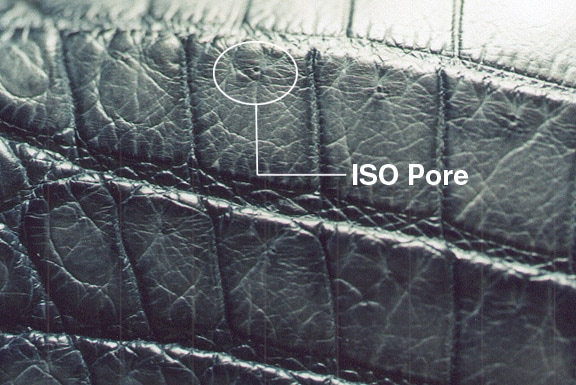
The most distinguishing feature of crocodile leather is the integumentary sensory organ pore. Crocodiles have a sensory hair on each scale that is used to feel their environment. After the hide is tanned the hair is gone but the pore in each scale remains. Close examination of the product will reveal these pores.
Flank Scales and Patterns
The flanks of the alligator have dense scales of even sizes, while the flanks of the caiman have uneven sizes and spaced scales.
